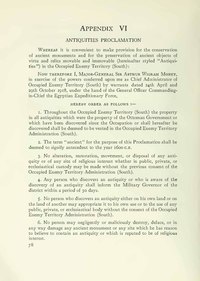Department of Antiquities (Mandatory Palestine)
The Department of Antiquities was a department of the British administration of Mandatory Palestine from 1920 to 1948 that was in charge of the protection and investigation of archaeological remains and artefacts in Palestine.
Operation[]

In December 1918, while Palestine was still under control of a British military administration, a Proclamation for the protection of antiquities was issued.[1][2] In July 1920, the military administration was replaced by a civil administration under High Commissioner Herbert Samuel. One of the first actions of the new government was to establish a Department of Antiquities and promulgate an Antiquities Ordinance that defined its functions and authority.[3] The Ordinance was designed to follow principles outlined in the abortive Treaty of Sèvres, which were later included as Article 21 in the Mandate for Palestine.[4] The main features of the Ordinance were:
- An "antiquity" was defined as any product of human activity before 1700 AD, though there was an exception for objects actively used for religious purposes.
- Authority from the department was required for the disposal or export of an antiquity.
- Permission from the department was required for excavations, and would only be given to "learned societies or institutions or to individuals of proved scientific competence guaranteed by such bodies".
- Proceeds from artefact discovery would be shared by the discoverer and the department in a proportion determined by the department, after objects needed for the "scientific completeness of the Palestine Museum" were chosen.
- The department had the power to expropriate or forcibly lease private property containing important artefacts if no satisfactory agreement with the owners could be reached.[4][2]
The Ordinance was replaced in 1929 and amended in 1934 and 1946.[2]
As well as a Director, the department had an Archaeological Advisory Board that included representatives of the major archaeological bodies and the main ethnic communities in Palestine.[4][5] The department included subdivisions for inspectors, a records office and library, a conservation laboratory, a photographic studio, and the museum.[6]
The department was located in a building called "Way House", north of the Old City of Jerusalem.[7] The British School of Archaeology in Jerusalem, established in 1919, also occupied the building until 1930.[7] The Palestine Archaeological Museum, which was managed by the department, was also in Way House until 1935, when it moved with the department to a new building in east Jerusalem donated by John D. Rockefeller.[7] The museum reopened to the public in 1938 and is now popularly known as the Rockefeller Museum.[7]
Directors[]
- 1920–1926 : John Garstang, also director of the British School of Archaeology and member of the Pro-Jerusalem Society's leading Council
- 1927–1937 : Ernest Richmond
- 1938–1948 : Robert Hamilton
Publications[]
In addition to many publications on particular sites, and official lists of sites, the department published a journal called the "Quarterly of the Department of Antiquities of Palestine" from 1931 to 1950.[7]
Successors[]
Since 1948, archaeology in Israel has been under control of the Israel Department of Antiquities.[6] Between 1948 and 1967, the Jordanian Department of Antiquities supervised excavations in the West Bank.[6] The Palestinian Department of Antiquities and Cultural Heritage has conducted work in the West Bank since 1994.[6]
See also[]
- Department of Antiquities
- American Schools of Oriental Research
- École biblique et archéologique française de Jérusalem
- Jewish Palestine Exploration Society
- Palestine Exploration Fund
References[]
Bibliography[]
- (1932): Quarterly Of The Department Of Antiquities In Palestine Volume: 1
- (1933): Quarterly Of The Department Of Antiquities In Palestine Volume: 2
- (1934): Quarterly Of The Department Of Antiquities In Palestine Volume: 3
- (1935): Quarterly Of The Department Of Antiquities In Palestine Volume: 4
- "Antiquities Ordinance, 1920". Official Gazette of the Government of Palestine. 29: 4–16. 5 October 1920.
"Antiquities Ordinance No. 51, 1929". Official Gazette of the Government of Palestine. 236: 548–554. 1 June 1929.
"Antiquities Ordinance No. 51, 1929". Official Gazette of the Government of Palestine. Gazette Extraordinary: 1190–1191. 31 December 1929.
"Antiquities (Amendment) Ordinance No. 24, 1934". Palestine Gazette (Suppl. 1). 459: 183–184. 23 August 1934.
"Antiquities (Amendment) Ordinance No. 62, 1946". Palestine Gazette (Suppl. 1). 1536: 261. 20 November 1946. - Bentwich, N. and F. M. Goadby (1925). "The Antiquities Law of Palestine". Journal of Comparative Legislation and International Law. 6 (iv): 251–254.
- Garstang, J. (1922). "Eighteen months' work of the Department of Antiquities for Palestine". Palestine Exploration Quarterly. 54 (2): 115–143.
- Gibson. S. (1999). "British archaeological institutions in Mandatory Palestine, 1917–1948". Palestine Exploration Quarterly. 131 (2): 115–143.
- Glock, A., L. Glock and N. Lapp (2005). "Archaeology". In P. Mattar (ed.). Encyclopedia of the Palestinians (Revised Edition). Facts On File, Inc. pp. 73–75.CS1 maint: uses authors parameter (link)
- Government of Palestine (1946). A Survey Of Palestine prepared In December 1945 and January 1946 for the Information of the Anglo-American Committee of Inquiry.
- Archaeology of Mandatory Palestine
- National archaeological organizations
